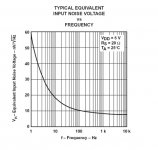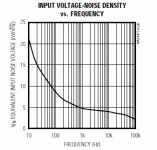Input RC filter
John, I would like to ask a question on input RC filter. In a preamp of BT or similar concept, to use it or not. I mean preamp that is fast, has no slew rate problems and has no special HF intermodulation problem. The input RC then, just reduces HF content for following power amp. What about sound? The cap in the RC filter would remain the only considerable cap in the audio path of the preamp.
Others, please no trivial answers are helpful.
John, I would like to ask a question on input RC filter. In a preamp of BT or similar concept, to use it or not. I mean preamp that is fast, has no slew rate problems and has no special HF intermodulation problem. The input RC then, just reduces HF content for following power amp. What about sound? The cap in the RC filter would remain the only considerable cap in the audio path of the preamp.
Others, please no trivial answers are helpful.
hitsware said:[B[snip] or else amps that graph
the same would sound the same, which
is clearly not the case.[snip][/B]
It is not? How do you know, is that your personal belief or can you back that up with anything?
Jan Didden
PMA: this similar filter make phase shift only a few degrees at 20 kHz, as you certainly know, which is not hearable. Or do you mean, that John will hear it ? 😎
I mean the capacitor influence on sound, and possible benefit of RF reduction vs. capacitor problem - I asked for no trivial answers, Upupa.
P.S.: Any lower rate college student could answer me about phase response, it is not helpful. I am asking for experience in this field.
P.S.: Any lower rate college student could answer me about phase response, it is not helpful. I am asking for experience in this field.
OK, I am very curious for his answer - I have not silver teflon caps, which are mandatory for best results... 😎
PMA, I tend to use a nominal filter with a few hundred ohm resistor and 100pf or so polystyrene, polypropylene, or mica only. Many decades ago, I worked with Otala to make 2 pole Bessel filters, but I think that is unnecessary with fet input.
john curl said:This amplifier example is a sick version of what is normally available from tube designs. Tubes almost always have some measured distortion, but even a Dyna that originally cost $100 new. will measure better than this example. Please, study first, before criticizing any audio component.
I have studied it and most of them measure poorly with a few exceptions. Look at all of the tube amps measured by Stereophile over the years and show me one that measures well in terms of distortion, frequency response into a real reactive load, square wave response etc. There are only a handful that really do and these aren't cheap.
These days if someone produced a solid state amp with inferior objective performance it would most likely be shunned upon 🙁 However if it is a tube amp somehow everybody is supposed to turn a blind eye to it and accept it just because the colorations and obvious imperfections subjectively sound better to some people even though as an amplifier it is doing a poorer job 🙁
hitsware said:You are missing my point. I am saying
that perhaps the 'magic' happens in
spite of the distortion, rather than
because of it. There are obviously other
things going on in amplifiers than how
they graph, or else amps that graph
the same would sound the same, which
is clearly not the case.
An engineer I worked for once said that any
distortion spec below 0.5 % was superflorus
in that other factors in the design would
affect the sound to a greater degree.
Then please specify these 'other things' otherwise you are using a fallacious argument to try and present your point.
Snoopy,
you are not right on tube preamps.
http://stereophile.com/tubepreamps/208bat/index4.html
and especially this one:
http://stereophile.com/tubepreamps/806mac/index4.html

you are not right on tube preamps.
http://stereophile.com/tubepreamps/208bat/index4.html
and especially this one:
http://stereophile.com/tubepreamps/806mac/index4.html

PMA said:Snoopy,
you are not right on tube preamps.
I was referring to power amps where the claims for the 'magical properties' of tubes still applies 😉
SY said:
Oh, THAT is comforting.🙄
Anything a reasonably well-equipped amateur could probe for? gm? Noise?
You can make a high gain common source amplifier with enough gain to overcome the noise of your sound card. Then look at the noise w/wo a 10k gate resistor (to provide a calibration). Seems to work so far even at 1nV. Watchout for high gm RF FETs relabeled they run .07$ in mass quantity. The picture at Ampslab looks laser branded, much better. The guys pic looked like a homemade silkscreen.
john curl said:Mosfets are VERY NOISY!!!!!!!! BIGTIME NOISE Gm is not the problem. It is 1/f noise. 1000 times more noise at 10 Hz than good jfet.
Read Willy Sansen: 'Noise Sources in MOSFET Transistors' Google it, please!
There are now buried channel MOSFETs, you should read up noise corners at 100Hz really I've measured them.
Notice date on reference below 1977, but I can't find the products now. Of course there are no discreets or never were any and I think only one flavor of MOSFET was super quiet.
National features a plot on their front page of some recent opamps with 35nV at 10Hz noise (400Hz corner). So things have improved, this looks more like 10 times worse not 1000.
Accession Number : ADA055787
Title : Integrated Low Noise Buried Channel MOSFET Preamplifier Technology.
Descriptive Note : Final technical rept. 1 Apr 76-30 Jun 77,
Corporate Author : TEXAS INSTRUMENTS INC DALLAS CENTRAL RESEARCH LABS
Personal Author(s) : Carrigan,D. G. ; Cheek,T. F. , Jr. ; Fu,H. S. ; Stephens,W. F. ; Tasch,A. F. , Jr
Report Date : DEC 1977
Pagination or Media Count : 94
Abstract : The objective of the effort was to establish the device design and processing guidelines necessary to fabricate an integrated buried channel MOS preamplifier using the current Texas Instruments buried channel MOSFET/CCD processing technology.
National features a plot on their front page of some recent opamps with 35nV at 10Hz noise (400Hz corner). So things have improved, this looks more like 10 times worse not 1000.
Accession Number : ADA055787
Title : Integrated Low Noise Buried Channel MOSFET Preamplifier Technology.
Descriptive Note : Final technical rept. 1 Apr 76-30 Jun 77,
Corporate Author : TEXAS INSTRUMENTS INC DALLAS CENTRAL RESEARCH LABS
Personal Author(s) : Carrigan,D. G. ; Cheek,T. F. , Jr. ; Fu,H. S. ; Stephens,W. F. ; Tasch,A. F. , Jr
Report Date : DEC 1977
Pagination or Media Count : 94
Abstract : The objective of the effort was to establish the device design and processing guidelines necessary to fabricate an integrated buried channel MOS preamplifier using the current Texas Instruments buried channel MOSFET/CCD processing technology.
Scott - do you have any parts numbers?
Regards,
Sigurd
Regards,
Sigurd
scott wurcer said:
I've measured them.
Sigurd Ruschkow said:Scott - do you have any parts numbers?
Regards,
Sigurd
Sorry it took me a while to find them, TI likes to push the BB parts these days - TLC220x. See picture B grade GUARANTEED 30nV @ 10Hz. I don't know what the capacitance figure of merit is but they could massively parallel for sub nV noise, there is no Ib penalty.
Attachments
scott wurcer said:TLC220x. See picture B grade GUARANTEED 30nV @ 10Hz. I don't know what the capacitance figure of merit is but they could massively parallel for sub nV noise, there is no Ib penalty.
Yes, I've used these (and other similar ones from LinCMOS series). There is also an excellent series of CMOS opamps from Maxim - MAX4475-4489 (thought the max. p/s is 5V only). Here is a typical noise plot for these. Typical 0.1Hz-10Hz noise is about 0.3 uV p-p for Maxim against 0.7 uV p-p for TI. Input capacitance is specified at 10pF for Maxim devices.
Cheers
Alex
Attachments
In short form, the exception (in mosfets) does not prove the rule. This is misleading, and I regret that people are willing to give false understanding to others, in able to make me look like I am overstating the case of the noisiness of mosfets.
I own a Quantech 2173c transitor (fet) noise analyzer. I have change the scales double decades or more to measure mosfets, after measuring quality jfets. My typical measurement is LESS than 1nV/rt Hz at 1KHz, and 2 nV at 10Hz. This is for just ONE fet, but I almost always use them in parallel, and at high current, so my typical input voltage noise for a Vendetta is 0.4nV / rt.Hz at 1kHz.
Please compare these numbers with your best mosfets.
Of course, typical power mosfets as we were ORIGINALLY talking about and referring to, are much noisier yet.
I own a Quantech 2173c transitor (fet) noise analyzer. I have change the scales double decades or more to measure mosfets, after measuring quality jfets. My typical measurement is LESS than 1nV/rt Hz at 1KHz, and 2 nV at 10Hz. This is for just ONE fet, but I almost always use them in parallel, and at high current, so my typical input voltage noise for a Vendetta is 0.4nV / rt.Hz at 1kHz.
Please compare these numbers with your best mosfets.
Of course, typical power mosfets as we were ORIGINALLY talking about and referring to, are much noisier yet.
john curl said:
Please compare these numbers with your best mosfets.
Of course, typical power mosfets as we were ORIGINALLY talking about and referring to, are much noisier yet.
I don't remember restricting it to power devices. Typical power MOSFETs have as much as 1000pF input C, hardly something for an input stage. Someone was floating a preamp schematic around that used an RF bipolar power device that had .38nV from the extremely low base spreading resistance they needed to get good noise figure at RF.
This is not helpful. Please read Willy Sansen or someone else on mosfet noise, before quibbling with me about it. I am trying to help people not to do something that will be costly in terms of noise.
Everyone, please reread posts: 5937 and 5938 on this thread to understand why I have said anything about mosfets at all. The phrase 'power mosfet' is in one of them
Everyone, please reread posts: 5937 and 5938 on this thread to understand why I have said anything about mosfets at all. The phrase 'power mosfet' is in one of them
- Status
- Not open for further replies.
- Home
- Amplifiers
- Solid State
- John Curl's Blowtorch preamplifier

